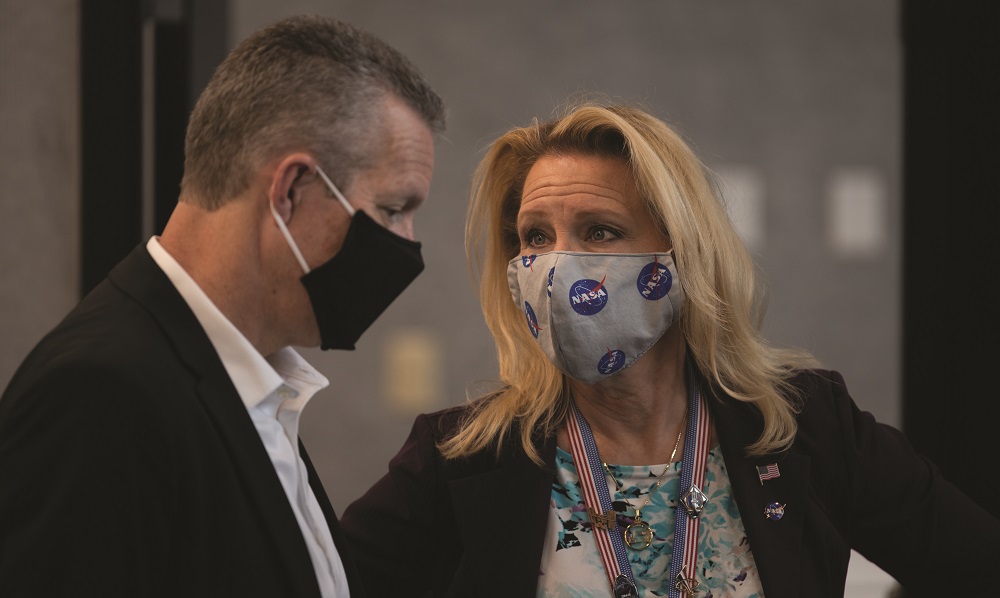Three months after the coronavirus pandemic upended American society, there are signs of recovery. States are rolling back some of their restrictions on businesses and public gatherings, hoping to undo the economic damage they caused even amid concerns that the pandemic is far from over.
NASA is also taking the first initial steps back to normal operations. In May, the agency published a plan for how its centers would de-escalate from the highest levels of its pandemic response plan, allowing them to gradually open up for more on-site work. A few centers have since gone from Stage 4 — the highest level, with only mission-essential work taking place — to Stage 3, which permits some more mission-critical activities at the centers.
The agency, though, isn’t rushing to reopen centers to broader work. “It will be a while before we have people stop telecommuting,” said Steve Jurczyk, NASA associate administrator, in a presentation at a joint meeting of the National Academies’ Aeronautics and Space Engineering Board and Space Studies Board June 9. “I cannot predict how long we will be in that mode.” Allowing more work on-site will depend on the availability of antibody tests or a COVID-19 vaccine, he suggested.
The pandemic, though, has already had permanent effects on how the agency operates. “Some things we won’t change because we learned how to do it better,” Thomas Zurbuchen, NASA associate administrator for science, told the National Academies committees. For example, NASA converted review panels of research proposals from in-person to online meetings. “Many of them are working really, really well” in the new format, he said. “We’re going to keep doing that.”
Jurczyk said the vast majority of NASA personnel have been able to work remotely, and he expected even after restrictions are lifted many people will continue to do so, either because they are in high-risk health categories or simply because they find it more efficient.
He envisioned a future where fewer employees had permanent offices. They would instead work from home much of the time, using a concept called “hoteling” where they reserved a desk for those times they needed to be on-site. “We could significantly reduce the office space required at headquarters and other locations if we’re doing way more telecommuting,” he said.
But what does NASA lose in a more telecommuting-centric future? “I know that we are missing some things because we’re not together,” Ken Bowersox, acting associate administrator for human exploration and operations, told the committees. “Sometimes you’ll get a 10-second snippet in a hallway from somebody, and it can save you a 30-minute meeting.”
Jurczyk agreed and explained that was one of the reasons why the final major reviews for the SpaceX Demo-2 commercial crew launch took place in person rather than online. “You can look somebody in the eye and say, ‘Are you OK? Are you good with this?’” he said, adding it also allowed for side conversations during breaks that aren’t feasible in a virtual meeting.
Telework is also stressing. Laptops and smartphones had long blurred the lines between home and office but extended telework has erased them. “One thing we worry about is burnout,” Jurczyk said. “People are working way more than 40 hours a week.”
“You can get to a point where folks are overloaded sooner than you would if you weren’t teleworking,” Bowersox said. “I’ve noticed that folks can get irritable more quickly if you’re not careful.”
That irritation can extend beyond NASA employees. “My wife just dreaded the ‘ding’” his smartphone made when a new message arrived, Jurczyk recalled, “because she knew that when I heard the ding, she wasn’t going to see me for 30 minutes or an hour, because I got a text message to get on the phone.”
As NASA adapts to a future of far greater teleworking, it’s also going to have to find ways to set limits, to avoid burnout and to preserve marriages.

Jeff Foust writes about space policy, commercial space, and related topics for SpaceNews.
His Foust Forward column appears in every issue of the magazine. This column ran in the June 15, 2020 issue.
